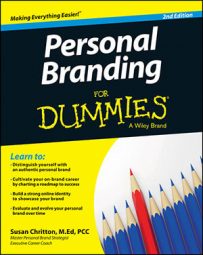Certified Personal Brand Strategist and Career Coach Randi Bussin outlines a goal-setting strategy and how you can best use it in developing your personal brand. Following are Randi’s own words to describe this process:
In Randi’s opinion, goal setting is a crucial exercise for career reinvention, job search, and personal branding coaching for the following reasons:
Goal setting helps you get clear on what you want.
Goal setting helps you identify what distractions may be blocking your success.
Goal setting, including writing your goals, helps program your subconscious mind and activate mental powers that will enable you to accomplish these goals.
Goal setting helps motivate you, especially when you get overwhelmed in today’s fast-paced society.
Goal setting leads to success, increased income, and greater career/life happiness.
Randi has identified ten steps to help you get through the goal-setting process:
Create a big picture of what you want to accomplish in your life.
Take a piece of paper and write down everything you want to accomplish in the next ten years. Or, use whatever format works for you — Microsoft Word or Excel, for example. Be sure to include goals for all major areas of your life:
Career
Education/professional development
Family
Financial
Health and physical condition
Hobbies and pleasure
Volunteer/community service
As you make a list of your goals, be sure they are what you want to achieve, and not something desired by others.
Prioritize the goals by time frame.
Break the long list of goals into three smaller time frames. When you prioritize your goals by time frame, it prevents you from feeling overwhelmed by having too many goals. It also helps you focus on the ones that are the most important and those you must hit in order to reach your longer-term lifetime goals. Three categories of goals Randi suggests that clients aim for are
Next 12 months (short term)
Two to five years (medium term)
Six to ten years (longer term)
Rewrite your short-term goals in SMART goal format and also be sure the goal is written as a positive statement.
SMART goals are
Specific: This means stating what you’re trying to accomplish and why.
Example: A general goal would be “Get in shape.” A specific goal would be “Join a health club and work out three days a week so I feel more energized during the day.”
Measurable: This establishes how you’re going to measure progress toward the attainment of the goal you have set. To determine whether your goal is measurable, ask yourself these questions:
How much?
How many?
How will I know whether I’ve achieved this goal?
Attainable: When you list goals that are important to you, you begin to find ways to make them come true. If it’s too far of a reach, you probably won’t commit to doing it and will get frustrated.
Relevant or Realistic: A realistic goal is an objective that you’re both motivated to achieve and realistically able to do so. Remember to set your goal high enough to stretch yourself. If the goal took a dispiriting time to accomplish, make the next round of goals a little bit easier.
Timely or Time-Bound: A goal should have a time frame associated with it. With no time frame, there’s no sense of urgency to reaching the goal.
Type your goals, put them in several places where you can see them, review them daily, and revise them as needed.
This action of putting your goals in a visible place sets the intention to the greater universe. Spend a minute every day in front of your list of goals and read them to yourself. Review your goals regularly and revise them if you reach them too easily or if they are too difficult.
Identify the obstacles that you have to overcome to achieve your goals.
What is going to get in the way of your achieving your goals?
Identify the knowledge, skills, and competencies you need to achieve your goals.
Which skills do you need to be at the top of your game? What one skill, if you developed it, would have the greatest impact on your life or career? Identify it and begin to work on it every single day.
Identify the support team you need in place to achieve your goals.
To achieve big goals, you need the help and support of many people. Who is your support team or board of advisers? Identify the list of family members, work colleagues, and mentors you need in your life. As you think about your support team, think about ways in which you can be a giver and not necessarily a taker.
Celebrate successes.
When you achieve a goal, take time to enjoy the satisfaction of having reached the milestone. Treat yourself to something to mark the accomplishment.
Organize your 12-month goals into smaller, more manageable steps, from the beginning to the completion of the goal.
Planning is very important to reaching your goals. The 80/20 rule states that 80 percent of your results will come from 20 percent of your efforts. So how will you spend your time? The more detailed you can be in outlining your activities, the more you’ll accomplish in less time. Plan the next 12 months, month by month. For each month, list two or three activities that you must accomplish.
Take action every day.
Randi always tells her clients that lots of baby steps add up to big goals. If you’re having a very busy week at work, don’t beat yourself up. Just do one thing, one little thing each day that will keep the momentum going and keep you moving forward.

